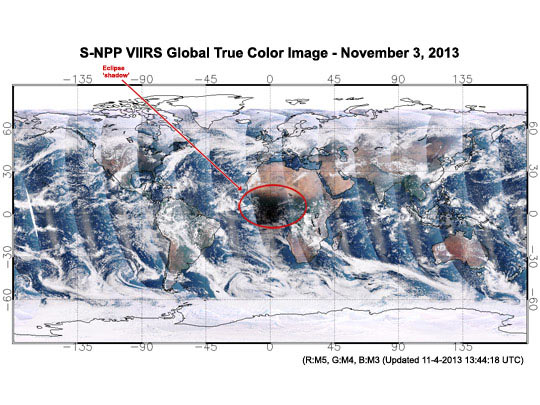Suomi NPP CrIS Calibration Image Captures the Footprint of a Solar Eclipse
8 November 2013 - An unusual partial solar eclipse was visible across much of the U.S. east coast as the sun rose on Sunday, November 3. Solar eclipses occur when the new moon lines up directly between the sun and Earth, appearing to cover the disk of the sun as seen from the planet's surface. Partial alignments allow for partial solar eclipses, and when the moon is too close to Earth to block the entire sun it creates a "ring of fire" eclipse, or annular eclipse.
STAR scientist Yong Chen and ICVS instrument team members recently discovered artifacts of Sunday's eclipse in instrument monitoring images from the Suomi NPP CrIS, OMPS, and VIIRS instruments. STAR's Yong Chen explained that the 'footprint' of the November 3 eclipse was captured in an ICVS instrument performance image using the 4.3µm CO2 of Non-Local Thermodynamic Equilibrium (NLTE) effect. NLTE emission occurs during daytime in the upper atmosphere (above 40 km), where the rates of creation and annihilation of photons due to solar pumping are greater than the rate of collisions. The Community Radiative Transfer Model (CRTM) simulates the NLTE effect for these strong CO2 absorption channels in CrIS. Under normal conditions, the difference between actual CrIS observations and CRTM simulation is about 1.0 K for these channels. When the solar eclipse occurred, the NLTE effect was subdued in the observations, but CRTM simulation still assumed normal non-eclipse conditions, resulting in the large difference between the two values.
The CrIS instrument performance chart at right illustrates this large difference between predicted and observed values. Additionally, its location was coincident with the location where the eclipse's maximum extent was visible. The Suomi NPP OMPS and VIIRS images from November 3 also show the eclipse's brief impact on the light reaching those instruments. The ICVS system captured the effect of the eclipse on satellite instrument readings elegantly and concisely.

CrIS observation compared to CRTM predicted radiance at 2230 µm-1
3 November 2013 - images from ICVS instrument teams

Path of the eclipse
3 November 2013 - Map courtesy of eclipse-maps.com .
.

VIIRS True Color Image
3 November 2013 - images from ICVS instrument teams

S-NPP OMPS Total Column Radiance at 331 nm
3 November 2013 - images from ICVS instrument teams
Acknowledgments:
- Special credit and thanks to the team members who discovered the evidence of the eclipse in the data: Yong Chen, Xin Jin, and Likun Wang.
- Description of the unique characteristics of this particular eclipse from
Joe Rao at Space.com
 .
. - The map of the eclipse's path is used with permission from
its creator Michael Zeiler at Eclipse-Maps.com
 .
.

